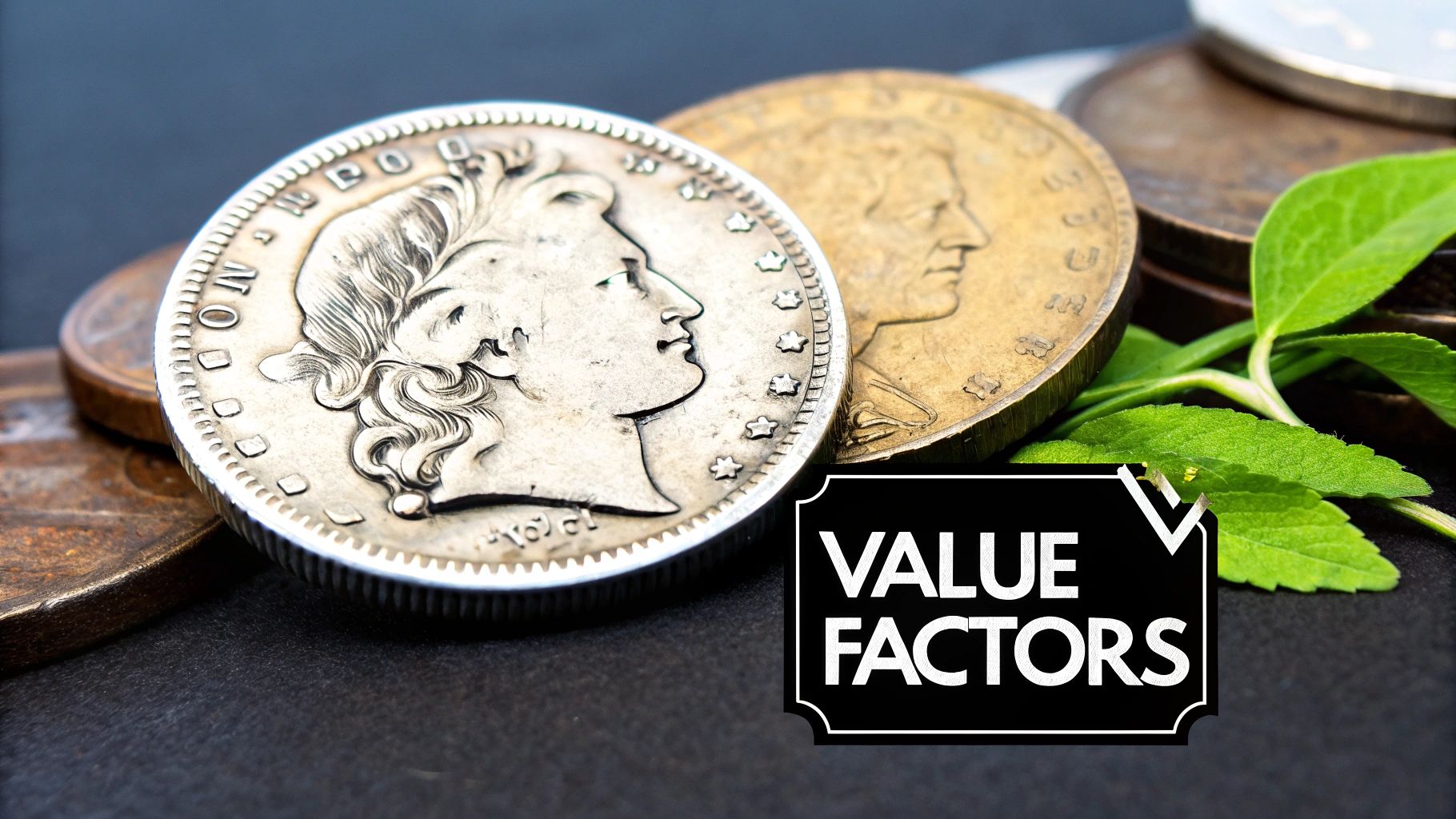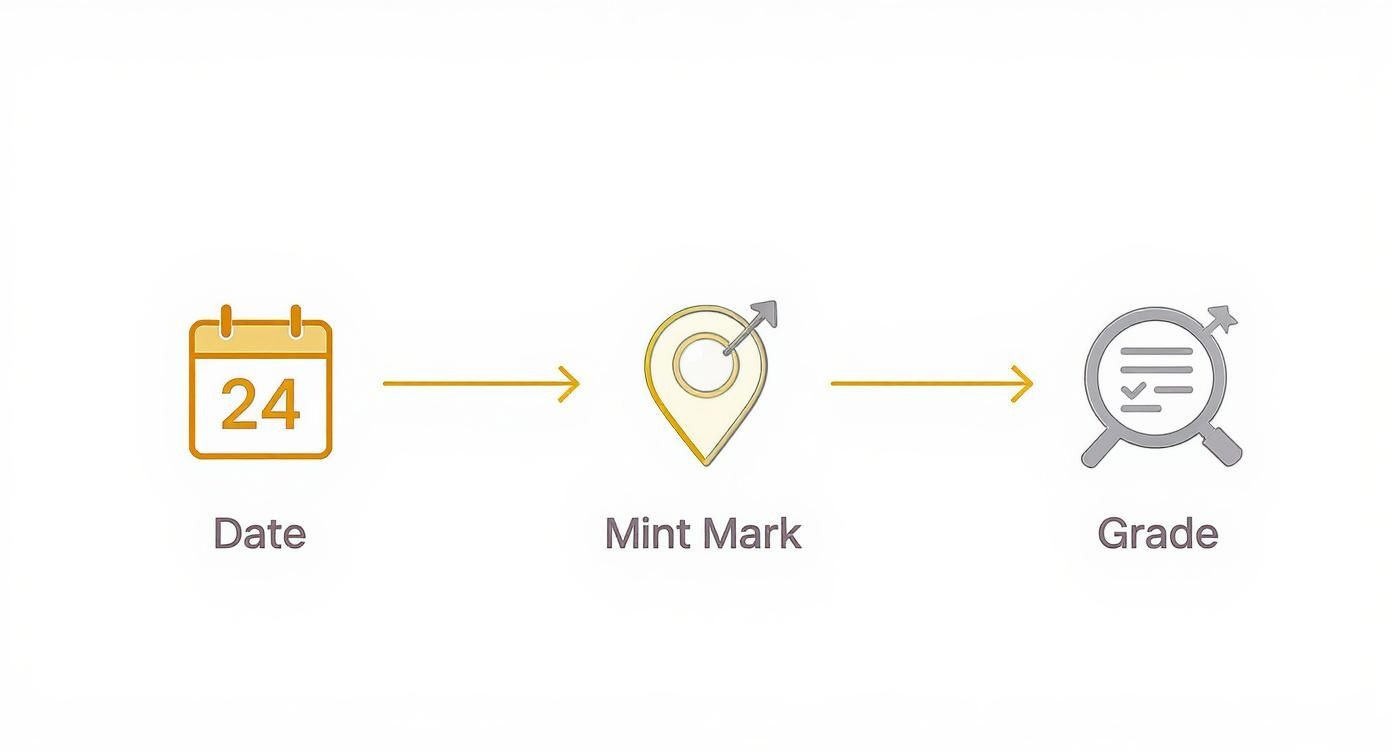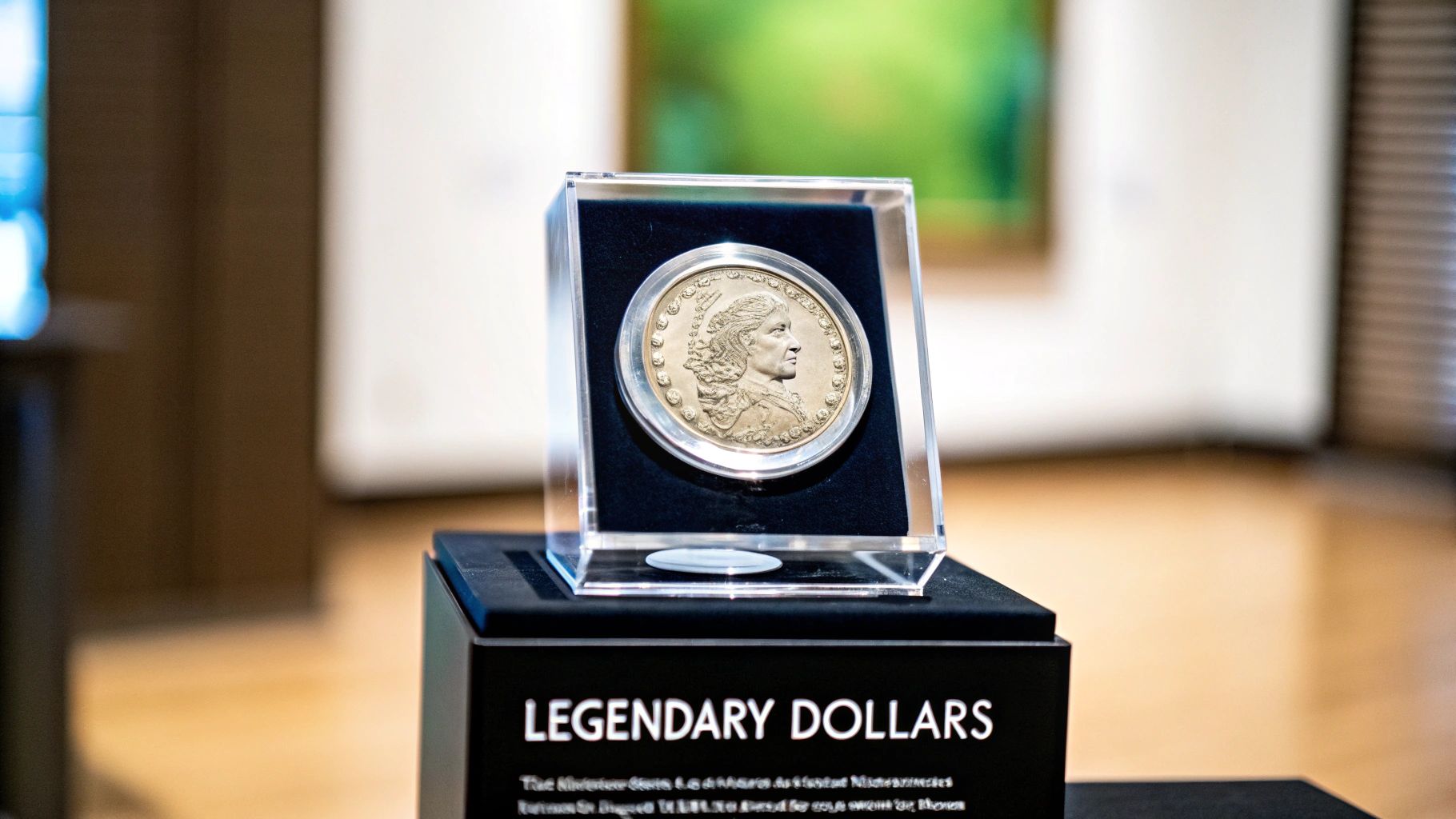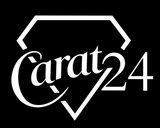You've probably heard stories of people finding old silver dollars worth a fortune. But you've also probably seen common ones selling for around $25-$30. So what gives?
This huge gap between a simple piece of silver and a prized collectible comes down to a few key factors. It’s not just about the metal—it’s about the story the coin tells.
What Really Drives Old Silver Dollar Coins Value

Ever wondered why one silver dollar is just worth its weight in silver, while an almost identical one can command thousands at auction? The secret is understanding the two kinds of value every collectible coin has: bullion value and numismatic value.
-
Bullion Value: This is the coin's floor price, tied directly to how much silver it contains. Think of it as the melt value, which changes daily with the ups and downs of the precious metals market. (You can learn more about how that works by reading our guide on the spot price for gold and silver).
-
Numismatic Value: Now, this is where things get interesting. Numismatic value is the collector's premium—what someone is willing to pay beyond the silver price. It's driven by rarity, historical importance, and the coin's physical condition.
Here's a simple analogy: a regular brick is worth the price of its clay and labor. But a brick from the original Roman Colosseum? That's a priceless artifact. The exact same principle applies to silver dollars.
The Four Pillars of Coin Value
To really get a handle on what your silver dollar is worth, you need to look at its unique "fingerprint." This is a combination of four crucial elements that separate the common coins from the true treasures. A coin's historical value can start at just a few dollars over its silver content but can skyrocket for the right combination of factors.
Here’s a quick breakdown of what to look for.
The Four Pillars of Silver Dollar Value
| Value Factor | What It Means | Impact on Price |
|---|---|---|
| Metal Content | The amount of precious metal (like silver) in the coin. | Establishes the coin's baseline or "melt" value. |
| Date & Mint Mark | The year the coin was made and the mint where it was struck. | Some combinations are incredibly rare, driving prices up. |
| Condition (Grade) | How much wear and tear the coin shows. | A pristine, uncirculated coin is always worth more. |
| Rarity & Demand | How many were made vs. how many collectors want one. | The classic supply-and-demand that can make prices soar. |
Each one of these factors adds another layer to the coin's story and, ultimately, its market price. A heavily worn, common-date dollar will always have a value tied closely to its silver content. But a crisp, perfectly preserved coin with a rare date and mint mark? That’s where you find the real treasures.
This is exactly why you need an expert eye when you're looking to sell. For folks here in the Boise area, working with a local specialist in Gold and Jewelry Buying ensures you understand the full value of what you have. We provide Xray Scanning and Gold Testing for free to give you clear, hassle free offers.
You can save the hassle and sell locally for more than online shipments with confidence. Plus, with our Price Matching guarantee, you know you're getting the highest payout in Boise.
The Story Behind Your Silver Dollars
To really get a feel for what an old silver dollar is worth, you have to look past the shiny metal and dig into its history. Every one of these coins is a tiny time capsule, telling you a story about the era it came from. The big events in history didn't just happen around these coins; they directly impacted why they were made, how many were struck, and which ones are still around today.
Here's a simple way to think about it: a 1921 Morgan dollar is a classic, but it's pretty common. You can find them without too much trouble. On the flip side, a 1794 Flowing Hair dollar is the stuff of legends—one sold for over $10 million. The massive price difference isn't just about age; it's about the unique story behind each coin's creation.
From Humble Beginnings to Iconic Status
The American silver dollar's official journey kicked off with the Coinage Act of April 2, 1792. This was a game-changing piece of legislation that set the standard for the new nation's currency, locking in the silver dollar's specific weight and purity. The very first dollars, struck in 1794, were made in small batches. This was a huge moment for the young United States, and that's why those early coins are incredibly rare today.
Over the years, the silver dollar's fate was tied to the country's ups and downs. Production would fire up and shut down depending on what the economy needed. After 1935, the U.S. Mint stopped making them for everyday use, marking the end of an era.
This historical context is the secret ingredient that creates numismatic value. A coin isn't just a piece of silver; it’s a tangible link to a specific moment in time, and that connection is what collectors are truly chasing.
Key Eras That Defined Silver Dollars
Getting a handle on the timeline is a must for anyone looking to collect or sell. The major production periods, often sparked by events like the California Gold Rush or big government silver purchases, are what gave us the classic coins we know and love.
- The Early Years (1794–1804): Home to the Flowing Hair and Draped Bust designs, these coins are the granddaddies of all U.S. silver dollars. Their tiny mintages and immense historical weight make them extraordinarily valuable.
- The Morgan Dollar Era (1878–1904, 1921): The Morgan dollar became the workhorse of American money, born out of massive silver discoveries out West. Its iconic look and the sheer number of them that circulated make it a perfect starting point for new collectors. If you're just getting into the hobby, check out our guide on how to start a coin collecting hobby for more tips.
- The Peace Dollar Era (1921–1935): Minted to celebrate the end of World War I, the Peace dollar is all about a nation's hope for a new chapter of calm. Its unique backstory and beautiful design perfectly capture the spirit of the Roaring Twenties.
This trip through time shows you why some coins are common pocket change and others are priceless treasures. When you're ready to sell your coins, especially here in Boise, it's crucial to work with an expert in Gold and Jewelry Buying who gets this history. We offer Xray Scanning and Gold Testing for free to confirm your coin's story and authenticity, making sure you get the highest payout in Boise. You can skip the hassle of shipping things off and sell locally for more, with hassle free offers and Price Matching.
Finding Clues in Dates and Mint Marks
Beyond a coin's general era, it's the smallest details stamped onto its surface that can make the biggest difference in value. Think of the year and the tiny letter indicating where a coin was made as its specific birth certificate. These little clues can transform a common piece of silver into a genuinely sought-after collectible.
A coin’s date tells you its mintage year, but the mint mark tells its origin story. This small letter, usually found on the reverse side, identifies which U.S. Mint facility struck the coin. For instance, a Morgan Dollar might have an 'S' for San Francisco, an 'O' for New Orleans, or no mark at all if it came from the main mint in Philadelphia.
The Power of Key Dates and Rare Mint Marks
Not all dates and mint marks are created equal. A key date is simply a year when a mint produced a very low number of a particular coin. The lower the mintage, the rarer the coin, which naturally drives up demand from collectors. The 1928 Peace Dollar from the Philadelphia mint, for example, is far scarcer than its counterparts from other years, making it a classic key date. This same principle of rarity applies across all historic U.S. coinage, as you can see when learning about the value of Mercury dimes.
The mint mark can be just as powerful, if not more so. Some mints, like the one in Carson City, had much smaller production runs than the industrial-scale facilities back east.
Any Morgan dollar bearing the "CC" mint mark from Carson City automatically carries a significant premium. This is because the Carson City Mint operated for a shorter period and produced far fewer coins, making every "CC" dollar a piece of Wild West history that collectors eagerly pursue.
A Tale of Two Coins
Let's look at a real-world example. An 1884 Morgan Silver Dollar with no mint mark (meaning it was made in Philadelphia) is quite common. In circulated condition, its value is closely tied to its silver content.
But an 1884-S Morgan Dollar from San Francisco? That's a different story entirely. It's a much rarer coin. In the exact same circulated condition, it can be worth hundreds of dollars, all because of that one tiny "S" on the back.
Here’s a quick guide to the common mint marks you'll find on classic silver dollars:
- (None) - Philadelphia, Pennsylvania
- S - San Francisco, California
- O - New Orleans, Louisiana
- CC - Carson City, Nevada
- D - Denver, Colorado
Spotting these little details is the first step to figuring out what your coins are really worth. When you bring your collection to us here in Boise, we offer Xray Scanning and Gold Testing for free to verify these details and confirm authenticity without any risk of damage. This simple, hassle-free process ensures you get a fair, transparent offer and the highest payout in Boise. You can skip the risk of shipping your coins away and save the hassle and sell locally for more than online shipments, backed by our Price Matching guarantee.
Grading Your Coins With Confidence
In the world of coin collecting, the condition of a silver dollar is just as important as its date and mint mark. This concept, known as grading, is often the single biggest factor that separates a coin worth its silver melt value from one treasured at thousands of dollars. Simply put, grading is all about assessing the amount of wear and tear a coin has seen since it first left the mint.
Think of it like a brand-new car fresh off the lot versus one that's been a daily driver for a decade. The new car is pristine—sharp lines, glossy paint, every detail perfect. The older car? It's got dings, scratches, and worn-down tires. Coins are exactly the same. A flawless, uncirculated coin is called Mint State (MS). On the other end of the spectrum, a heavily worn coin might be graded as Good (G-4), where the main design is still visible but most of the finer details are long gone.
This infographic breaks down how the key details—date, mint mark, and grade—all come together to determine what your coin is ultimately worth.

As you can see, these three elements are a team. A weakness in one area, like a poor condition, can seriously drag down the premium you might expect from a rare date or mint mark.
Key Wear Points To Check
To get a feel for grading your own coins, you have to know where to look. Just like the treads on a tire, a coin's highest points are the first to show wear. For Morgan and Peace dollars, these spots are dead giveaways of their condition.
- Lady Liberty's Hair: Look closely at the strands of hair just above her ear and eye. On a high-grade coin, these details will be sharp and distinct.
- The Eagle's Breast Feathers: Flip the coin over. The feathers on the eagle's chest are a prime target for wear. A well-preserved coin will show clear, individual feather details.
- Cheek and Jawline: Lady Liberty's cheek is another high point that quickly picks up scuffs and loses its luster from circulation.
Keeping that original condition intact is everything. Once you know how to properly care for a coin, its grade is essentially locked in. You can learn more in our detailed guide on how to store silver coins to prevent any further damage.
Here's a golden rule every collector lives by: never clean your coins. Cleaning strips away the coin's natural surface, or patina, and leaves behind tiny, abrasive scratches. It instantly gets the coin classified as "damaged" and tanks its numismatic value.
To help you get started, here is a simplified chart to help you estimate the grade of your coins by looking for a few key features.
| Grade | General Appearance | Key Details to Check |
|---|---|---|
| Uncirculated (MS) | Looks brand new with original mint luster. No signs of wear. | Sharp, complete details everywhere. May have small bag marks from minting. |
| About Uncirculated (AU) | Almost perfect, with only the slightest hint of wear on the highest points. | Most of the mint luster is still present. Look for a tiny bit of rubbing on the cheek and hair. |
| Extremely Fine (XF) | Light wear is visible on the high points, but all major details are clear. | Hair strands are mostly visible but slightly flattened. Eagle's breast feathers show some wear. |
| Very Fine (VF) | Moderate wear is evident. Major design elements are still clear. | Hair and feathers are worn but still defined. Liberty's cheek will be smooth. |
| Good (G-4) | Heavily worn, but the main design and lettering are still readable. | Most fine details are gone. The rim is full, but the overall design is flat. |
This table is just a starting point, but it gives you a solid idea of what to look for when you're sorting through your silver dollars.
When To Seek Professional Grading
If you think you have a particularly valuable coin, getting a professional opinion is a must. Reputable services like PCGS (Professional Coin Grading Service) and NGC (Numismatic Guaranty Corporation) will authenticate and grade your coins, then seal them in protective holders. This certification gives your coin a universally recognized grade and almost always helps it command a higher price.
However, professional grading isn't cheap. For a trustworthy local assessment, especially when it comes to Gold and Jewelry Buying, come see us in Boise. We provide Xray Scanning and Gold Testing for free to give you an accurate evaluation of your coins. You can save the hassle and sell locally for more than online shipments, getting hassle free offers and the highest payout in Boise, backed by our Price Matching guarantee.
Legendary Coins and What Makes Them Valuable

Beyond the common treasures you might find tucked away in an old collection, a few silver dollars have achieved legendary status in the coin world. These are the titans of numismatics, the coins that shatter auction records and make history.
Understanding what gives these specific pieces their incredible value is the ultimate lesson in how rarity, historical significance, and pristine condition can create an absolute masterpiece. These aren't just coins; they're foundational artifacts of American history.
Take the 1794 Flowing Hair Silver Dollar. It’s widely believed to be the very first official silver dollar the U.S. ever minted. Back in 2013, a stunning specimen sold at auction for over $10 million, a record that speaks volumes about its historical importance. You can dig deeper into the story of these amazing coins and their history over at westminstermint.com.
The King of American Coins
Then there's the mythical 1804 Draped Bust Silver Dollar, famously known as the "King of American Coins." Here's the twist: despite the date, these coins weren't actually struck until decades later, created specifically for diplomatic gift sets.
Today, only 15 examples are known to exist. That extreme rarity is exactly why one sold for a staggering $4.1 million all the way back in 1999, cementing its place in the history books.
While the odds of finding a multi-million-dollar coin are slim, these stories perfectly illustrate the principles that drive the entire market for old silver dollar coins value. They show how a coin can be worth far more than its silver content when its story is exceptional.
What This Means for Your Collection
These legendary coins set the high-water mark for what’s possible in the world of collecting. They’re proof that every single factor—from a coin's backstory to how well it was preserved—plays a part in its final value. Whether you think you have a hidden treasure or just want to understand a family collection, getting an expert evaluation is the only way to know for sure.
For those of us here in Boise, our Gold and Jewelry Buying services provide a transparent and profitable path to understanding what you truly own. We offer Xray Scanning and Gold Testing for free to authenticate your items without causing any damage.
You can save the hassle and sell locally for more than online shipments, securing the highest payout in Boise. We stand by our Price Matching and hassle free offers.
How to Sell Your Silver Dollars in Boise
Once you’ve figured out what your old silver dollars might be worth, the real question becomes: how do you turn that potential into actual cash? If you're in the Boise area, finding the right buyer is the single most important step to getting a great payout without all the stress.
Sure, you could try selling online, but that world is filled with risks. You're left shipping valuable, irreplaceable items across the country and hoping for the best with a buyer you've never met. It can be a nerve-wracking process.
There's a much better way. Working with a trusted local expert in Gold and Jewelry Buying offers a safer, more transparent, and often more profitable alternative. There's real peace of mind in a face-to-face transaction—no anxiety about your collection getting lost in the mail.
The Benefits of Selling Locally
Choosing a local buyer means you get immediate, professional service and can walk out with payment in hand the very same day. No waiting, no shipping fees, and zero uncertainty. A reputable local shop provides a transparent and educational experience from the moment you walk in.
You'll want to find a buyer who offers a few key services that protect you and your coins.
- Xray Scanning and Gold Testing for free: This is a big one. Non-invasive tech like an X-ray scanner can verify your coins' authenticity and metal content without leaving a single scratch, preserving their full numismatic value.
- Hassle-Free Offers: You should get a clear, no-obligation offer based on a transparent evaluation. This lets you make an informed decision without feeling pressured.
- Price Matching: A buyer who is confident in their valuation will stand by their offer. Many will even provide Price Matching, which is your guarantee of receiving the highest payout in Boise.
The best way to save the hassle and sell locally for more than online shipments is to partner with an expert who values transparency. A direct, in-person appraisal builds trust and ensures you fully understand how your coins are valued.
By choosing a local expert, you're not just getting a better price; you're supporting a local business that's committed to fair, honest practices. The process is straightforward, secure, and designed to give you the maximum possible value for your silver dollars.
For a deeper dive into maximizing your returns, you can learn more about how to sell collectible coins in our comprehensive guide.
Common Questions About Silver Dollar Value
Diving into the world of old silver dollars can bring up a lot of questions, especially when you're trying to figure out what a coin is actually worth. Whether you're just starting a collection or you've inherited a box of old coins, getting straight answers is key. Let's tackle some of the most common questions we hear.
Are All Old Silver Dollars Valuable?
Not necessarily. It's a common misconception. While it's true that any U.S. dollar made before 1936 is made of silver, its real-world value comes down to rarity and condition.
A very common coin, like many 1921 Morgan dollars, might only be worth its "melt value"—the price of the silver it contains. There are just so many of them out there. But a coin with a rare date or a coveted mint mark, like the "CC" for Carson City, can be a different story. If that same coin is in pristine, like-new condition, its value can jump into the hundreds or even thousands. It's all about what a collector is willing to pay.
How Can I Tell If My Silver Dollar Is Authentic?
Spotting a fake can sometimes be surprisingly easy if you know what to look for. Here are a couple of quick home tests you can do.
First, grab a scale. A genuine Morgan or Peace dollar should weigh exactly 26.73 grams. Next, try the magnet test. Real silver isn't magnetic, so if your coin snaps to a magnet, you know it's not the real deal. Also, just look at it closely. Fakes often have a soft, blurry look to the details that just feels off.
For a coin that might be valuable, guessing isn't good enough. A professional eye is a must. Here in Boise, we take the guesswork out of it with our Gold and Jewelry Buying services. We use non-invasive Xray Scanning and Gold Testing for free to confirm authenticity and provide hassle free offers on the spot.
Should I Clean My Silver Dollars Before Selling Them?
Let me be crystal clear: absolutely not. Whatever you do, never clean your coins.
It's tempting, I know. But cleaning, no matter how gently you think you're doing it, leaves tiny scratches all over the coin's surface. It also strips away the natural toning—what collectors call "patina"—that develops over decades. In the coin world, a cleaned coin is considered damaged goods, and its value plummets instantly.
To get the highest old silver dollar coins value, leave them exactly as you found them. An experienced buyer will always prefer an original, untouched coin, grime and all. That history is part of its charm. For folks in the Boise area, our experts will assess your coins as-is, ensuring you get the highest payout in Boise without accidentally damaging them.
When you're ready to find out what your collection is truly worth, visit Carat 24 - Trusted Gold Experts. We offer Price Matching and professional Gold Testing for free. You can save the hassle and sell locally for more than online shipments with our trusted, transparent service.


